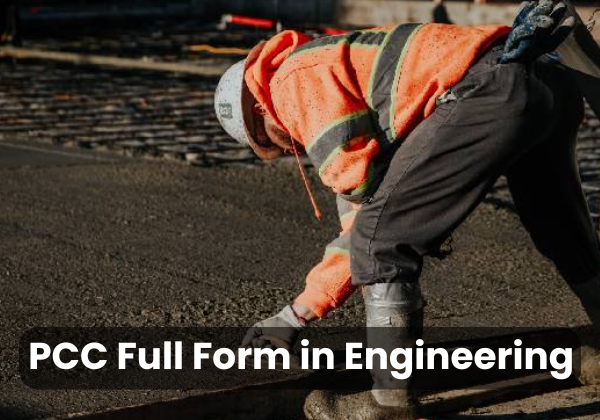Full Form of PCC in Engineering: In the field of civil engineering, terms like RCC, PCC, and DPC are frequently used in both academic and practical applications. Among these, PCC plays a fundamental role in ensuring a stable foundation for construction. If you’re a civil engineering student or a competitive exam aspirant, understanding what PCC stands for and its relevance is essential.
What is PCC in Civil Engineering?
The PCC full form in Civil Engineering is Plain Cement Concrete. It is a mixture of cement, fine aggregates (sand), coarse aggregates (gravel or crushed stone), and water. Unlike Reinforced Cement Concrete (RCC), PCC does not contain any steel reinforcement. Its primary purpose is to provide a strong and level base for structural elements like footings, beams, and slabs.
Importance of PCC in Construction
PCC is often laid before starting any structural work on a construction site. It forms the foundation bed for structures to prevent direct contact between the soil and reinforced concrete. This minimizes the risk of corrosion and adds to the longevity of the structure.
Key Purposes of PCC:
-
Acts as a protective layer for RCC foundations
-
Provides a uniform and clean base for structural elements
-
Prevents soil contamination and moisture ingress
-
Distributes the load evenly from the structure to the ground
Mix Ratio and Components
The standard mix ratio used in PCC varies depending on the purpose of the construction. Commonly used mix ratios include:
| Mix Ratio (Cement:Sand:Aggregate) | Application Purpose |
|---|---|
| 1:2:4 | Flooring, foundation base |
| 1:3:6 | Light footings, levelling surface |
| 1:4:8 | Below flooring or non-structural use |
Major Ingredients of PCC:
-
Cement: The binding material (generally OPC 43 or 53 grade)
-
Fine Aggregate: Clean river sand or M-Sand
-
Coarse Aggregate: Crushed stone or gravel
-
Water: Potable water used for hydration
Procedure of Laying PCC
Proper laying of PCC ensures the strength and stability of the overall structure. The process includes the following steps:
-
Site Preparation: The surface is excavated, leveled, and compacted.
-
Formwork: Wooden or steel formwork is set to hold the concrete in shape.
-
Mixing: Cement, sand, and aggregate are mixed in the prescribed ratio with water.
-
Pouring: The mix is poured into the formwork and leveled.
-
Compaction: A vibrator or tamping rod is used to remove air bubbles.
-
Curing: The surface is cured with water for at least 7 days to gain strength.
Applications of PCC in Civil Engineering
PCC finds its application in various civil engineering works:
-
Foundation base for RCC footings
-
Road pavements and highway constructions
-
Sub-base for flooring in residential and commercial buildings
-
Canal linings and drain constructions
-
Levelling and protection layers in industrial structures
Advantages of PCC
-
Economical and easy to use
-
Reduces corrosion of reinforcement in RCC
-
Provides a firm surface for further construction
-
Improves durability of the structure
If you’re preparing for civil engineering exams or aiming to pursue a career in construction, mastering concepts like PCC will enhance your technical understanding and project execution skills.
PCC Full Form in Civil Engineering FAQs
Q1. What is the full form of PCC in civil engineering?
Answer: In civil engineering, PCC stands for Plain Cement Concrete. It is a construction material made using cement, fine aggregates (sand), coarse aggregates (gravel), and water, without any reinforcement like steel bars.
Q2. Why is PCC used in building construction?
Answer: PCC is used to create a level and strong base before laying structural elements like columns and footings. It helps in distributing the load uniformly, prevents direct contact of RCC with soil, and reduces the risk of corrosion in reinforcement.
Q3. What is the standard mix ratio for PCC?
Answer: The commonly used mix ratios for PCC are 1:2:4, 1:3:6, or 1:4:8 (cement:sand:aggregate), depending on the requirement and type of construction. For example, 1:2:4 is often used for moderate structural work, while 1:4:8 is suitable for non-structural leveling layers.
Q4. What is the difference between PCC and RCC?
Answer: The key difference is that PCC (Plain Cement Concrete) does not contain any reinforcement (steel bars), while RCC (Reinforced Cement Concrete) includes steel to handle tensile stresses. PCC is used for simple leveling and foundation beds, whereas RCC is used for load-bearing structures.

